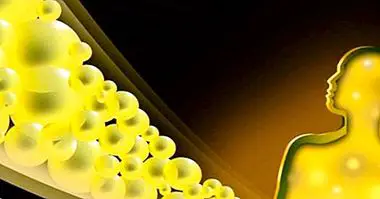Premenstrual syndrome: causes, symptoms, treatment and remedies
3 out of 4 women report symptoms such as anxiety, headache, acne, fatigue or sadness, among others, when menstruation approaches; these cases are known as premenstrual syndrome .
In this article we will analyze the causes and symptoms of premenstrual syndrome, including its most serious form, premenstrual dysphoric disorder . Also we will detail the treatments and home remedies by means of which these alterations can be fought.
- Related article: "Types of hormones and their functions in the human body"
Premenstrual syndrome and premenstrual dysphoric disorder
Premenstrual syndrome is defined as a varied set of physical, emotional and behavioral symptoms that appear after ovulation , between one and two weeks before menstruation. They usually cease after the period begins.
It is estimated that approximately 80% of women have suffered symptoms of premenstrual syndrome at some point in their lives. It is more usual to occur after 30 years , in women who have had children or with a history of depression, both personal and family. Symptoms tend to get worse as menopause approaches.
Premenstrual dysphoric disorder is a severe variant of premenstrual syndrome that affects about 3-8% of women of childbearing age . Unlike premenstrual syndrome, premenstrual dysphoric disorder is considered pathological insofar as it interferes with the normal functioning of those who suffer it.
In 2013, premenstrual dysphoric disorder was included in the DSM-5. This conception of disorder has been criticized by many people who think that it may have negative consequences for women at a socioeconomic level and that it was invented by pharmacists to sell medicines. On the other hand, some people think that the existence of this diagnosis will increase awareness of the biological basis of this type of symptoms.
Symptoms and signs
Among the most frequent physical symptoms and signs We found the appearance of acne breakouts, fatigue, distension and abdominal cramps, colic, constipation, diarrhea, headache, back, muscles and joints, swelling and sensitivity in the breasts, food cravings and weight gain due to fluid retention.
The psychological symptoms of premenstrual syndrome They include concentration difficulties, decreased mood, anxiety, tension, insomnia, irritability, aggression, mood swings, crying, social withdrawal and variations in sexual desire.
The majority of women who feel symptoms of premenstrual syndrome claim that they only suffer from some of the alterations that we have mentioned. In general, the pattern of appearance of symptoms is predictable.
In cases of premenstrual dysphoric disorder the psychological and emotional symptoms are usually especially intense ; For example, feelings of sadness can become hopeless, and irritability and anger can facilitate the appearance of conflicts with other people.
Causes of premenstrual syndrome
The alterations of the premenstrual syndrome are related to the luteal phase of the menstrual cycle, also called 'postovulation'. During this time the unfertilized egg disintegrates to be subsequently expelled in the bleeding.
In the luteal phase, the ovules secrete progesterone, a hormone involved in pregnancy, the sexual impulse, the regeneration of the dermal tissue, the coagulation of the blood, the growth of the breasts and breast cancer.
It is believed that dysregulation in the production of progesterone and other hormones , which affects different women in a variable way, influences the development of premenstrual syndrome. On the other hand, fluctuations in the neurotransmitter serotonin could partly explain symptoms such as fatigue, emotional lability, insomnia and cravings.
The emotional symptoms would be intensified by the presence of stress or depression, while alterations in the levels of sodium, minerals or vitamins would increase some of the physical signs, such as fluid retention and abdominal swelling derived from it.
There are also hypotheses that affirm that sociocultural factors could also contribute to the appearance of premenstrual syndrome and premenstrual dysphoric disorder.
Treatment and remedies
Are used different medical and psychological treatments, as well as home remedies , to reduce the symptoms of premenstrual syndrome. Below you can see the most common and effective.
1. Changes in diet
Limiting the consumption of salt and copious meals can reduce fluid retention, belly swelling and the feeling of having a full stomach. In contrast, it is recommended to eat foods rich in calcium and complex carbohydrates. Avoid coffee and alcohol It can also relieve some symptoms.
2. Physical exercise
Do moderate aerobic exercise , such as swimming, cycling or brisk walking, is useful to treat fatigue, depressed mood and weight gain. It is recommended to play sports for half an hour a day at least 5 days a week.
- Related article: "The 10 psychological benefits of practicing physical exercise"
3. Stress reduction
To relieve stress and related symptoms, such as anxiety, insomnia, irritability and headache, it is effective Sleep between 7 and 9 hours each night and do relaxation exercises . The progressive muscular relaxation, the slow and deep breathing, the yoga and the massages are some options endorsed by the investigation.
- Maybe you're interested: "6 easy relaxation techniques to combat stress"
4. Non-steroidal anti-inflammatories (NSAIDs)
Taking non-steroidal anti-inflammatory drugs can be effective in relieving cramps, cramps and headaches, back and sinuses. Ibuprofen, naproxen and diclofenac are included in this category of analgesics.
5. Diuretics
Diuretics such as spironolactone may be recommended to reduce swelling and weight gain caused by fluid retention in cases where the exercise and limitation of salt intake are insufficient.
6. Antidepressants
Research has found that selective serotonin reuptake inhibitors, such as fluoxetine, sertraline, or paroxetine, are effective in treating the emotional symptoms of premenstrual syndrome, although can cause side effects such as nausea and vomiting .
Although the effect of antidepressants is more potent if taken daily, for moderate cases of premenstrual syndrome it is usually sufficient to do so during the days before menstruation, when symptoms are expected to occur. Yes, it is essential to have the medical indication to use these products.
7. Hormonal contraceptives
Contraceptive pills are prescribed in cases of premenstrual syndrome and premenstrual dysphoric disorder in which the physical symptoms are severe. However, the consumption of these drugs may increase the risk of developing cardiovascular diseases and cancer . In the same way, it is necessary to have the corresponding medical indication.
8. Nutritional supplements
Supplements of calcium, magnesium, vitamin E and vitamin B6 They can help reduce the symptoms of premenstrual syndrome, especially breast tenderness, cramping and fluid retention.
9. Herbal remedies
Among the most used herbal remedies to treat premenstrual syndrome are ginger, ginkgo, soy, St. John's wort, chasteberry and evening primrose oil.
It must be borne in mind that scientific studies have not endorsed this type of therapies at the moment, so that their efficacy, side effects and interactions with other drugs are not clear.



















